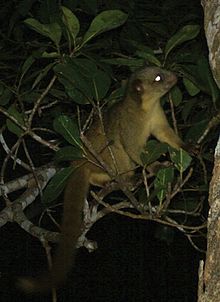Bassaricyon alleni
| Eastern lowland olingo | |
|---|---|
 |
|
| César M. Aguilar Photo, ZooKeys. Yambrasbamba, Bongará, Amazonas, Peru. |
|
| Scientific classification | |
| Kingdom: | Animalia |
| Phylum: | Chordata |
| Class: | Mammalia |
| Order: | Carnivora |
| Family: | Procyonidae |
| Genus: | Bassaricyon |
| Species: | B. alleni |
| Binomial name | |
|
Bassaricyon alleni Thomas, 1880 |
|
 |
|
| Black points mark the range of B. alleni | |
| Synonyms | |
|
Bassaricyon beddardi Pocock, 1921 |
|
Bassaricyon beddardi Pocock, 1921
Bassaricyon medius siccatus Thomas 1927
The eastern lowland olingo (Bassaricyon alleni) is a species of olingo from South America, where it is known from the lowlands east of the Andes in Bolivia, Brazil, Colombia, Ecuador, Guyana, Peru and Venezuela. It is the only olingo species found east of the Andes. The Latin species name honors Joel Asaph Allen, the American zoologist who first described the genus Bassaricyon.
The eastern lowland olingo is smaller than the northern olingo, but larger than the recently described olinguito ("little olingo"), the most montane member of the genus. It is larger than the western lowland olingo subspecies B. medius medius from west of the Andes, but about the same size as the B. m. orinomus subspecies from eastern Panama. The pelage is slightly darker than the western species.
It has a head-body length of 30 to 45 centimetres (12 to 18 in), with a tail length of 40 to 53 centimetres (16 to 21 in). It weighs 1.1 to 1.5 kilograms (2.4 to 3.3 lb).
The closest relative of the eastern lowland olingo is the western lowland species, B. medius, from which it diverged about 1.3 million years ago.
...
Wikipedia

